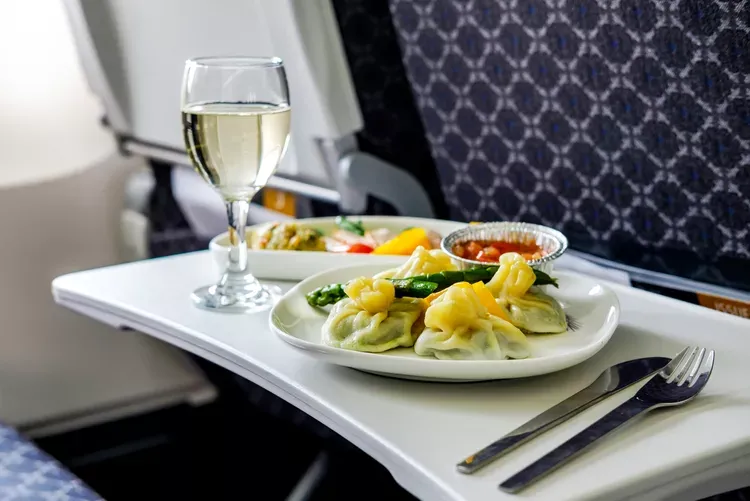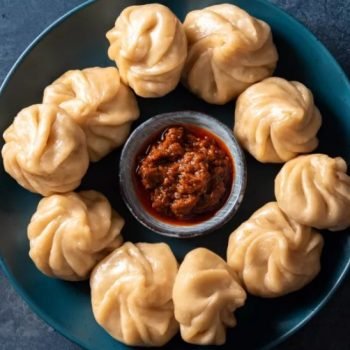Plane food costs can become annoying, but the first question you should answer is whether or not a meal will be served at no cost.
Fliers are so focused on what the airlines don’t provide these days that they sometimes (wrongly) assume that no meal will be provided for flights.
Asian and European airlines frequently provide meals.
The policy varies by airline, so there’s no ironclad rule you can use to determine if a plate of food will be set on your tray table. But most long-haul flights (four hours or more) include at least one meal, and some trans-oceanic flights will include several feedings.
On short flights, you are unlikely to be served a meal. On budget airlines, you will pay for snacks and drinks as well as meals.
Don’t buy plane food elsewhere if it’s included in your airfare. When you book your flight, it’s easy enough to make a quick check of the food offerings.

Avoid Alcohol
Airlines love to serve overpriced alcohol at every possible opportunity. They’ve made it easier through the years to buy a cocktail or other spirits right at your seat with the swipe of a credit card. It produces a revenue stream the airlines simply cannot resist, and many travelers demand it.
Unlike food services, alcohol always has involved added expense for air travelers. Ordering several drinks can put a dent in your travel budget before you stagger off the plane.
Snacks are Still Free on Many Airlines
How about some plantain chips?
It’s a popular snack in Panama, and therefore Air Panama serves each passenger on its domestic flights a small bag of these chips and a can of soft drink. No charge — it’s included in the price of the ticket.
Many airlines still pour a small glass of soda for their passengers or hand them a bag of pretzels or peanuts. It’s certainly not a meal, but it might quiet the hunger and thirst pangs for a little while.
Budget airlines are another story. They operate on the assumption that travelers want to pay only for what they use. That keeps airfares low, but it can mean $6 for that bag of chips or those few swallows of soft drink. If that’s more than you want to pay for such basic comforts, read on…
Pack Sandwiches that Won’t Spoil
It was once unnecessary (and even odd) for air travelers to pack their own meals. Those days are gone. No one will think twice about your stowed snack or meal. But it’s important to pack wisely.
After all, you don’t know how long you will wait to board the plane and get permission to fold down that tray table, do you?
It’s safest to stick with items that will hold up much longer. Peanut butter is a good choice. It’s filling and packs plenty of protein for your jaunts down lengthy airport corridors.
As a matter of courtesy, avoid spicy or aromatic foods that could stink up your section of the plane. Keep it simple and non-perishable.
Limit Salty Snacks
The dehydrating effects of alcohol were mentioned in step #2. But many more air travelers become dehydrated consuming sweet or salty snacks.
I know they’re tasty, and in small portions you’re unlikely to experience problems. But if you’re one of those people who can’t stop eating pretzels, potato chips or peanuts, resist the temptation to carry on large bags of those items on the flight.
Healthy choices are even more important in the air than on the ground.
Drink plenty of water — in fact, accept every offer of free water you receive from the flight crew. This becomes greatly significant on longer flights, during which dehydration becomes more likely.
Small Serving Containers
Many budget travelers like to save single-serving containers they receive in restaurants or in carry-out orders for use on the plane. It’s not a bad idea, but it raises questions very quickly about whether or not carry-on knives of any kind are permissible beyond the security checkpoints.
In the U.S., the TSA naturally lists knives among its prohibited carry-on items. But they do make a provision to exempt “plastic or round bladed butter knives.” So long as you choose an acceptable utensil, you can spread to your heart’s content.
Keep in mind that these rules are subject to change and vary by country. So don’t be shocked or upset if a security officer tells you the butter knife you’re carrying is unacceptable.
Fruits are Good Choices
One more word about dehydration — fruits can help combat that potential problem. They create a healthy and filling alternative to what most airlines will offer as a free snack.
Naturally, some fruits work better than others on an airplane. Bananas and apples are fairly mess-free. The bag of cherries or an orange might prove to be sloppier than you’d like for a flight where napkins will be limited in availability.
Again, for economy’s sake — buy these items at your local grocery store, not inside the terminal. They can be taken through security checkpoints.
Eat Before You Fly
It’s a simple solution to the plane food question, and yet many people practice it inside the terminal of the airport, where food costs are quite high.
It takes some planning and discipline, but time your pre- and post-flight meals so that they take place 2-3 hours from departure. On short-haul flights, this is relatively easy to do.
But if you’re going to be spending half the day on an aircraft, you’ll need nourishment during the flight. Fortunately, as we’ve noted, most long-haul flights still include a free meal or meals. But you should plan to eat at a time that will enable you to skip the expensive airport food options and yet not feel hungry during the first part of your flight, when the meal service still could be several hours away.
Avoid Airport Restaurants
There are some great airport restaurants. You’re bound to want to eat if you’ve got several hours to kill during a layover. And if you get bumped from an overbooked flight on which you had a confirmed seat, the offending airline will most likely issue an airport meal voucher for your use.
Why are airline restaurants so expensive? Setting up a business within a secured area and ferrying employees back and forth across an airport costs extra money. Depending upon the airport, some of the spaces can be extremely expensive to rent and maintain. It’s only natural that the restaurants pass along some or all of these costs to the consumer.
That’s why you pay $14 for a fairly ordinary hamburger or $12 for an average salad. But with some planning, you can create a healthy and inexpensive meal alternative that doesn’t include overpriced food.
Avoid Overpriced Bottled Water in Terminals
By now, even novice travelers know they cannot get bottled water through security checkpoints. It will be confiscated, or you’ll be asked to drink it before entering the checkpoint. The TSA liquids rule for U.S. flights is that all fluids carried on must be in quantities of three ounces or less.
If you want to sip water in the terminal, chances are you’ll pay a high price. For that reason, many budget travelers will carry an empty water bottle in their carry-on baggage and then fill it with water from a drinking fountain on the other side of the checkpoint.
Be sure to drink up before the boarding calls begin!

